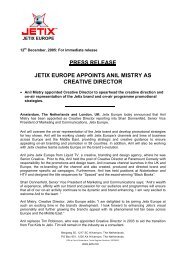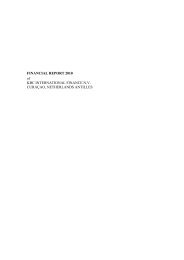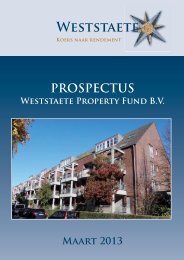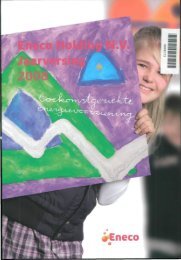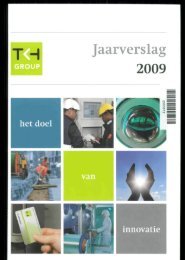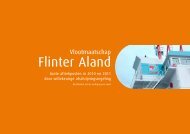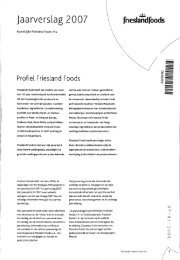Pallet-Management-Services - AFM
Pallet-Management-Services - AFM
Pallet-Management-Services - AFM
You also want an ePaper? Increase the reach of your titles
YUMPU automatically turns print PDFs into web optimized ePapers that Google loves.
Key assumptions used in the annual in use calculation:<br />
The Company projected the cash flows for the five-year period<br />
based on detailed assumptions for every cash-generating<br />
unit and its specific markets. The model used is the same the<br />
Company used in prior years providing a profit and loss account,<br />
balance sheet and cash flow statement as well as assumptions<br />
for key performance indicators.<br />
The calculation of value in use is sensitive to the assumptions<br />
for<br />
Market share – as well as using industry data for growth rates<br />
management assesses how the position of the three cash<br />
generating units, relative to its competitors, might change over<br />
the budget period.<br />
Gross margins – key elements for all three cash generating<br />
units are logistic costs (e.g. transportation, washing, labor) and<br />
material price development for <strong>Pallet</strong>-<strong>Management</strong>-<strong>Services</strong>.<br />
Based on average values achieved in prior periods, these costs<br />
are projected by including anticipated effi ciency improvements<br />
and cost developments related to portfolio changes.<br />
Future investment needs in the RPC pool based on trip growth<br />
at average turn rates and maintenance to replace broken crates<br />
and shrinkage.<br />
<strong>Management</strong> has assessed these factors and their possible<br />
future impacts very carefully to build up the projection.<br />
The Company used for risk free interest rates 20 year EUR-<br />
Germany-Sovereigns and EUR-Composite-AAA. In order to<br />
cover the additional risks IFCO SYSTEMS used appropriate<br />
public market equity risk premiums and estimated risk premiums<br />
in relationship with the actual rating of the companies shares.<br />
The beta factor used also reflected the actual bond rating of<br />
IFCO SYSTEMS.<br />
The Company’s fourth quarter 2006 and 2005 annual testing<br />
indicated that there was no impairment of goodwill.<br />
Property, plant and equipment<br />
Plant and equipment is stated at cost less accumulated<br />
depreciation and any impairment in value. The carrying values<br />
of plant and equipment are reviewed for impairment either<br />
annually, or when events or changes in circumstances indicate<br />
the carrying value may not be recoverable (whichever is earlier).<br />
If any such indication exists and where the carrying values<br />
exceed the estimated recoverable amount, the assets or cashgenerating<br />
units are written down to their recoverable amount.<br />
The recoverable amount of property, plant and equipment is the<br />
| FINANCIAL REPORTING | NOTES TO CONSOLIDATED FINANCIAL STATEMENTS |<br />
greater of net selling price and value in use. In assessing value<br />
in use, the estimated future cash flows are discounted to their<br />
present value using a pretax discount rate that reflects current<br />
market assessments of the time value of money and the risks<br />
specific to the asset. For an asset that does not generate largely<br />
independent cash inflows, the recoverable amount is determined<br />
for the cash-generating unit to which the asset belongs.<br />
Included in property, plant and equipment is the Company’s<br />
Reusable Plastic Container (RPC) pools (carrying amount<br />
US $288.1 million in 2006 and US $214.4 million in 2005).<br />
The Company takes historical information into consideration in<br />
determining an appropriate useful life for depreciating the RPC<br />
rental pools such as technical useful life, shrinkage, commercial<br />
useful life and market acceptance of crates. The limited factor<br />
for the determination is the commercial useful life and market<br />
acceptance of crates. Therefore, the Company depreciates its<br />
own RPCs of the pool for fruit and vegetables to their residual<br />
value using the straight-line method over 8 years, however other<br />
RPC pools and the acquired CHEP RPC assets over periods<br />
ranging from 2 to 8 years.<br />
Effective October 1, 2006, the Company has adjusted its RPC<br />
pool residual value estimates, based on the development of the<br />
value of granulated RPCs. Accordingly, the estimated residual<br />
values of the RPCs have been increased, resulting in lower<br />
depreciation in Q4 2006 as compared to prior year quarter in<br />
the amount of US $2.0 million. Based on the Company’s current<br />
property, plant and equipment balances, the Company estimates<br />
that this revised residual value will result in reduced depreciation<br />
expense in the amount of approximately US $7.8 million per year<br />
in future years.<br />
As RPCs break or otherwise become unusable, the Company<br />
facilitates the conversion of the RPCs into plastic granulate<br />
inventory. As part of the Company’s finalized RPC replacement<br />
and upgrade program, the Company transferred old RPCs to the<br />
supplier and only paid for production costs and other incidental<br />
acquisition costs for new RPCs.<br />
Expenditures for maintenance and repairs are charged to<br />
expense as incurred. Additions and replacements or betterments<br />
that increase capacity or extend useful lives are added to the<br />
cost of the asset. Upon sale or retirement, the cost and related<br />
accumulated depreciation are eliminated from the respective<br />
accounts and the resulting gain or loss is included in other<br />
(expense) income, net, in the accompanying consolidated<br />
income statements.<br />
75



